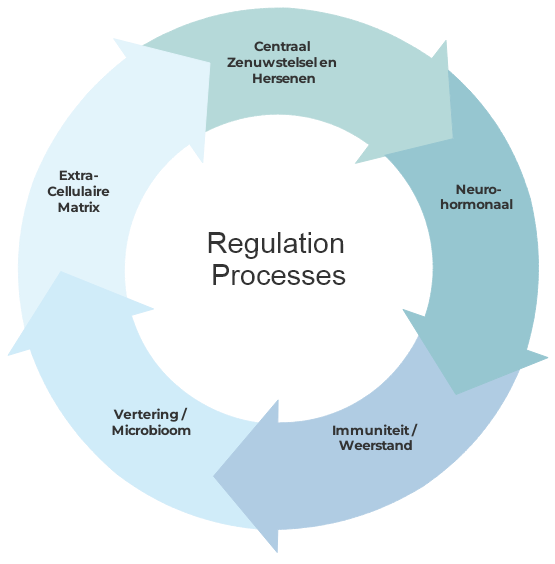The relationship between regulatory processes
Five central regulatory processes
THE FIVE REGULATORY PROCESSES FOR OUR MENTAL AND PHYSICAL HEALTH
BALANCE IN NEUROTRANSMITTERS AND NEUROMODULATORS
Brain and nerve health
Brain and nerve health
The balance between neurotransmitters (signal substances in the nervous system) and neuromodulators (substances that control different neurotransmitters) and the sensitivity of the receptors (receivers) that receive these signals determines brain health. The brain is at the top of the internal hierarchy.
FUNCTIONING OF THE AUTONOMOUS NERVOUS SYSTEM AND HORMONES
Neuro-hormonal health
Neuro-hormonal health
Neuro-hormonal health involves the functioning of the autonomic nervous system and hormones. The brain decides what is threatening or not. The stress response begins deep in the brain in a structure called the Hypothalamus. This center sends a signal to the adrenal glands that react with the production of adrenaline. Adrenaline prepares the body for the stress response. This phase, in which adrenaline therefore plays the main role, is the immediate response to stress. The brain then deploys the elite troops: the hypothalamic-pituitary-adrenal (HPA) axis in which the nervous, endocrine and immune systems together respond to the disruption.
DEFENSE SYSTEM AGAINST DISEASES AND INJURIES
Immune health
The immune system is the defense system against internal and external pathogens and injuries. The immune system is also used to clear away waste products or diseased body cells. We distinguish first-line defense and second-line defense. The first-line defense is a body’s own barrier that keeps harmful substances out, such as the skin or the mucus layer in the intestines. The second-line defense is formed by a defense line in the blood when harmful substances or pathogens enter the body.
COMMUNICATION BETWEEN THE INSIDE AND OUTSIDE WORLD
Extracellulair matrix health
The extracellular matrix consists of connective tissue and fluid that is located between the cells. The extracellular matrix is the last link between the supply and drainage structures and the nervous system and the individual cells. The extracellular matrix is primarily the main communication system between the inner world (inside the cells) and the outer world, as well as providing strength and structure to tissues.
A LITTLE STRESS IS NOT WRONG, BUT NOT RECOVERING RESULTS IN A BURN-OUT
Stress
Central regulatory processes allow the body to adapt to the circumstances that life brings. Inwardly oriented processes monitor the internal balance, outwardly oriented processes monitor the external balance and respond to external influences. If there is a disturbance of that balance, we talk about stress. Life without stress does not exist. More often than is consciously experienced, stress finds its way into the body. We roughly distinguish between three types of stress:
ESSENTIAL FEATURE: BIOMATRIX MODEL
Coherence
Biocoherence bases its working method on the ‘Biomatrix theory‘ system model. This scientifically developed meta-model describes system dynamics based on processes. A process always has a direction and a goal, just like a river flows from high to low and eventually flows into the sea.
We distinguish two types of processes. Inward oriented processes are part of the internal dynamics. Outward oriented processes mean that we as humans are part of a larger whole, the living environment, social structures, economic traffic, our work, etc. The internal processes must ensure that the estimated 35-40 trillion cells and their cohesion, staying in a good condition, under constantly changing circumstances.
HET BIOMATRIX MODEL: EFFECTS
Example – The Metabolic Syndrome
Example – The Metabolic Syndrome
We can best illustrate looking at health from the perspective of processes by means of an example.
Metabolic syndrome is a common metabolic disorder. It is estimated that 40-50% of the Dutch population is affected by this. As is known, the syndrome comprises a set of symptoms that occur with a disturbed glucose metabolism. It is at the root of obesity, cardiovascular disease, high blood pressure, disturbed blood lipids (cholesterol and triglycerides) and type 2 diabetes. The central disturbance in this syndrome is insulin resistance.
[sibwp_form id=1]







